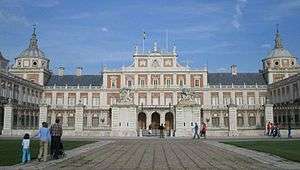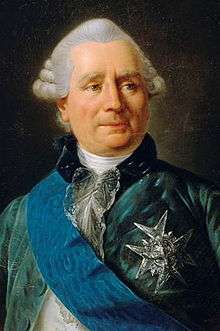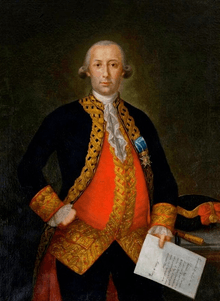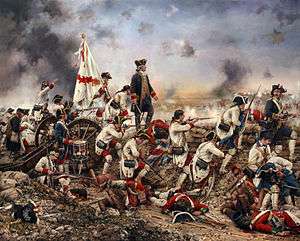Treaty of Aranjuez (1779)
The Treaty of Aranjuez (1779) was signed on 12 April 1779 by France and Spain. Under its terms, Spain agreed to support France in its war with Britain, in return for French assistance in recovering the former Spanish possessions of Menorca, Gibraltar and the Floridas.
Long name:
| |
|---|---|
 The Royal Palace in Aranjuez where the Treaty was signed | |
| Context | Spain agrees to support France by declaring war on Great Britain, thereby becoming involved in the American Revolutionary War |
| Signed | 12 April 1779 |
| Location | Aranjuez |
| Negotiators | |
| Parties | |
By declaring war on Great Britain on 21 June 1779, Spain became involved in the American Revolutionary War.
Background

The 1713 Treaty of Utrecht that ended the War of the Spanish Succession confirmed British possession of the Spanish island of Menorca and the port of Gibraltar, giving them naval dominance in the Western Mediterranean. During the Seven Years' War in 1756, Britain lost Menorca to France but captured the key Spanish colonial cities of Havana and Manila in 1762.

As part of the 1763 peace settlement, Britain regained Menorca and exchanged Havana and Manila for the Spanish colonies of East Florida and West Florida. France compensated Spain for these losses by transferring ownership of Louisiana (see Map).[lower-alpha 1]
West Florida controlled entry to the Mississippi River through the port of Mobile and included the Gulf Coast areas of modern-day Louisiana, Mississippi, Florida and Alabama. Both Floridas were overwhelmingly Loyalist and refused invitations to the First Continental Congress in 1774.[1] When the American Revolutionary War began in 1776, the British blockade of New England meant Spanish ports such as New Orleans and Havana became a vital supply route for the colonists.
This support was provided unofficially since Spain's Chief Minister, Count Floridablanca, hoped diplomacy would persuade Britain to return Menorca, Gibraltar and the Floridas and remove illegal settlements in Central America. Peace with Britain was viewed as essential for his domestic reforms, while Spanish colonies in the Americas or New Spain were vulnerable to British naval power. This concern was heightened by border disputes with Britain's ally Portugal over the Río de la Plata basin.[2]
Several minor wars were fought over this and other territorial disputes, the latest being the 1776-1777 Spanish–Portuguese War. In October 1777, Portugal and Spain settled their differences by the First Treaty of San Ildefonso, followed by the Treaty of Pardo in March 1778. Unlike the 1762-1763 Spanish-Portuguese War, the American War meant Britain was unable to help its ally; as a result, Portugal remained neutral.
In February 1778, France and the United States signed a Treaty of Alliance, in which France recognised US independence and provided military support. The American War now became part of a wider, global conflict, undermining efforts to reach a diplomatic solution with Britain. On 12 April 1779, France and Spain signed the Treaty of Aranjuez and Spain formally declared war on Britain on 21 June.[3]
Provisions

The terms of the Treaty were largely confidential; Spain agreed to support France's war with Britain, in return for French assistance in recovering Gibraltar, Menorca and Florida. One important feature of the Treaty was that Spanish forces would only attack British possessions outside the United States; Spain did not recognise US independence until the Peace of Paris in 1783.[4]
Both Charles III and Floridablanca were concerned by the potential impact of the American Revolution on Spain's own colonies, which had an important role in plans for modernising and expanding the Spanish economy.[5] In addition, there had been constant disputes over encroachment by American colonists into New Spain before the war; once the United States replaced Britain, future conflict was inevitable.[6]
Another less well-known impact of the Treaty is arguably still current today. France agreed in a secret clause to continue the war until Spain recovered Gibraltar, while the 1778 Franco-American Treaty committed the signatories not to make a separate peace. The combination effectively tied US independence to Spain's recovery of Gibraltar, without the knowledge of the Continental Congress.[7] The result was a deep and abiding distrust of 'foreign entanglements.'
Aftermath


The Treaty of Aranjuez effectively made Spain part of the Revolutionary War but its role is often overlooked, since officially it was not involved. In addition, while Spain's biggest impact was on the war in America, by far its greatest investment of money and men was on the Great Siege of Gibraltar that began in June 1779.
Between 1779-1781, Bernardo de Gálvez, Governor of Louisiana, captured West Florida and parts of East Florida, securing the Mississippi supply route and expelling Britain from the Gulf Coast. His contribution is remembered by the city of Galveston, Texas, which is named after him and he was awarded honorary US citizenship in December 2014.[8]
The Spanish agreed to defend the French West Indies, allowing Admiral de Grasse to intercept a British relief convoy at the Battle of the Chesapeake in September 1781. By preventing resupply of the garrison, Chesapeake forced Cornwallis to surrender Yorktown in October, a decisive point in the achievement of US independence.[lower-alpha 2]
In 1782, Menorca fell to a combined French and Spanish fleet.[lower-alpha 3] With the capture of the Floridas, these constituted significant successes for Spain. However, the largest effort was devoted to the Great Siege of Gibraltar which after three years had made little progress despite enormous expenditures of both money and men.
.jpg)
The imposition of heavy taxes and 'voluntary' donations to pay for the war caused unrest in much of the Spanish Empire, including the 1781 Revolt of the Comuneros in New Granada. By 1782, French finances were also exhausted and began negotiations with Britain on a peace settlement in April. At first Spain insisted on continuing the war until Gibraltar fell, as stipulated by the Treaty of Aranjuez but withdrew that requirement after the disastrous repulse of a combined French and Spanish assault in September 1782.
Under the Peace of Paris, Britain returned Menorca and the Floridas, allowing Spain to claim success although the loss of Gibraltar remains an issue to this day, while in reality the Floridas were of little value.[9] In the longer-term, concerns about an independent United States on New Spain's borders were justified, with constant encroachments by American settlers and disputes such as the West Florida Controversy. Spain's involvement in the 1792-1802 French Revolutionary Wars led to France repossessing Louisiana in 1800, which it later sold to the US in the Louisiana Purchase of 1803. The US acquired Florida in July 1821, ending Spain's presence in mainland North America.[lower-alpha 4]
Footnotes
- Not to be confused with the modern US state of Louisiana.
- Ironically, Cornwallis was one of five peers who voted against the 1765 Stamp Act out of sympathy with the colonists.
- Britain offered Menorca to Russia in a desperate bid for their support and to counteract Russian negotiations with an American embassy that included a 13 year old John Quincy Adams.
- It technically ended on 24 August 1821 when the Treaty of Córdoba recognised an independent Mexico, including large parts of the modern US; in reality, Spain ceased to exercise control long before that date.
References
- Duve, Thomas (ed), Donlan, Sean Patrick (2014). Spanish West Florida and the American Territory of New Orleans 1803-1810 in Entanglements in Legal History. epubli GmbH. p. 219. ISBN 3944773004.CS1 maint: extra text: authors list (link)
- Owens, David (1993). "Spanish—Portuguese Territorial Rivalry in Colonial Río de la Plata". Yearbook (Conference of Latin Americanist Geographers). 19: 15–24. JSTOR 25765781.
- Marley, David (1998). Wars of the Americas: A Chronology of Armed Conflict in the Western Hemisphere (2008 ed.). ABC-CLIO. p. 321. ISBN 1598841009.
- Paullin, Charles Oscar, Davenport, Frances Gardiner (1917). European Treaties Bearing On the History of the United States and Its Dependencies (2017 ed.). Andesite Press. p. 168. ISBN 1376158531.
- Stein, Stanley, Stein, Barbara (2003). Apogee of Empire: Spain and New Spain in the Age of Charles III, 1759–1789. Johns Hopkins University Press. pp. 338–340. ISBN 0801873398.
- Renouf, Stephen. "Spain in the American Revolution" (PDF). Spain Society; SAR. sar.org. Retrieved 16 June 2018.
- Weeks, William (2013). The New Cambridge History of American Foreign Relations: Volume 1 (2015 ed.). Cambridge University Press. p. 27. ISBN 1107536227.
- "H.J.Res.105 - Conferring honorary citizenship of the United States on Bernardo de Gálvez y Madrid, Viscount of Galveston and Count of Gálvez". Congress.gov. Retrieved 20 December 2014.
- Kaplan, Lawrence (September 1983). "The Treaty of Paris, 1783; A Historiographical Challenge". International History Review. 5 (3): 431–442.
Sources
- Marley, David; Wars of the Americas: A Chronology of Armed Conflict in the Western Hemisphere; (ABC-Clio, 2008 ed.);
- Owens, David; Spanish—Portuguese Territorial Rivalry in Colonial Río de la Plata; (Conference of Latin Americanist Geographers Yearbook);
- Paullin, Charles Oscar, Davenport, Frances Gardiner; European Treaties Bearing On the History of the United States and Its Dependencies; (Andesite Press, 2017 ed);
- Renouf, Stephen; Spain in the American Revolution; (https://members.sar.org/media/uploads/pages/309/TJx3jcf0O6up.pdf);
- Stein, Stanley & Stein, Barbara; Apogee of Empire: Spain and New Spain in the Age of Charles III, 1759–1789; (Johns Hopkins University Press, 2003);
- Weeks, William; The New Cambridge History of American Foreign Relations: Volume 1; (Cambridge University Press, 2015 ed);
- Revolution: Diplomacy